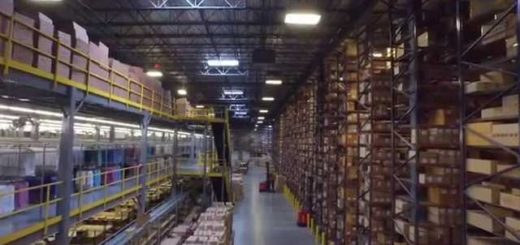Your Guide to the Amazon Supply Chain.
Introduction
Welcome to Your Guide to the Amazon Supply Chain! This guide is designed to provide you with an overview of the Amazon supply chain and how it works. We will discuss the different components of the Amazon supply chain, from the suppliers to the customers, and how they all work together to create a successful and efficient supply chain. We will also discuss the different strategies Amazon uses to ensure that their supply chain is running smoothly and efficiently. Finally, we will discuss the different challenges Amazon faces in managing their supply chain and how they are addressing them. So, let’s get started!
How Amazon Leverages Its Supply Chain to Deliver Products Quickly and Efficiently
Amazon has become one of the world’s leading e-commerce companies, and its success is largely due to its efficient supply chain. Amazon has leveraged its supply chain to deliver products quickly and efficiently to customers around the world.
Amazon’s supply chain is highly integrated and optimized for speed and efficiency. The company has invested heavily in technology and automation to streamline its operations. Amazon’s warehouses are equipped with automated systems that can quickly pick, pack, and ship orders. The company also uses sophisticated algorithms to optimize its inventory management and distribution networks.
Amazon has also invested in its own transportation network. The company owns a fleet of trucks and planes that can quickly deliver products to customers. Amazon also works with third-party carriers to ensure that orders are delivered on time.
In addition, Amazon has developed a network of fulfillment centers around the world. These centers are strategically located to ensure that orders can be delivered quickly and efficiently. Amazon also works with local carriers to ensure that orders are delivered on time.
Finally, Amazon has invested in its customer service. The company has a team of customer service representatives who are available 24/7 to answer customer questions and resolve any issues. Amazon also offers a variety of shipping options, including same-day delivery, to ensure that customers receive their orders quickly.
By leveraging its supply chain, Amazon has been able to deliver products quickly and efficiently to customers around the world. The company’s investments in technology, automation, and customer service have enabled it to become one of the world’s leading e-commerce companies.
The Benefits of Amazon’s Automated Supply Chain Management System
Amazon’s automated supply chain management system is a powerful tool that can help businesses of all sizes improve their efficiency and profitability. By automating the supply chain process, Amazon can reduce costs, improve customer service, and increase the speed of delivery.
One of the primary benefits of Amazon’s automated supply chain management system is cost savings. By automating the supply chain process, Amazon can reduce the amount of time and money spent on manual labor, such as order processing and inventory management. This can result in significant cost savings for businesses, as they no longer need to hire additional staff to manage the supply chain process. Additionally, Amazon’s automated system can help businesses reduce their inventory costs, as it can accurately track and manage inventory levels.
Another benefit of Amazon’s automated supply chain management system is improved customer service. By automating the supply chain process, Amazon can ensure that orders are processed quickly and accurately. This can help businesses provide better customer service, as customers can receive their orders faster and with fewer errors. Additionally, Amazon’s automated system can help businesses reduce their customer service costs, as they no longer need to hire additional staff to manage customer inquiries.
Finally, Amazon’s automated supply chain management system can help businesses increase the speed of delivery. By automating the supply chain process, Amazon can ensure that orders are processed quickly and accurately. This can help businesses reduce the time it takes to deliver orders to customers, as orders can be processed and shipped faster. Additionally, Amazon’s automated system can help businesses reduce their shipping costs, as they no longer need to hire additional staff to manage the shipping process.
Overall, Amazon’s automated supply chain management system is a powerful tool that can help businesses of all sizes improve their efficiency and profitability. By automating the supply chain process, Amazon can reduce costs, improve customer service, and increase the speed of delivery.
Exploring the Different Components of Amazon’s Supply Chain
Amazon is a global leader in the e-commerce industry, and its success is largely due to its efficient supply chain. The company has developed a complex system of warehouses, transportation networks, and customer service centers that enable it to deliver products quickly and reliably. In this article, we will explore the different components of Amazon’s supply chain and how they work together to create a seamless customer experience.
First, Amazon has a vast network of warehouses located around the world. These warehouses are used to store products and fulfill orders. Amazon has invested heavily in automation technology, which allows them to quickly and accurately process orders. This helps to ensure that customers receive their orders quickly and without any issues.
Second, Amazon has an extensive transportation network. The company uses a combination of ground, air, and sea transportation to move products from warehouses to customers. Amazon has invested heavily in its transportation infrastructure, which allows it to deliver products quickly and reliably.
Third, Amazon has a customer service center that is available 24/7. This center is staffed with knowledgeable customer service representatives who are available to answer questions and resolve any issues that customers may have. This helps to ensure that customers have a positive experience when shopping with Amazon.
Finally, Amazon has invested heavily in technology to ensure that its supply chain is efficient and reliable. The company uses sophisticated algorithms to optimize its supply chain and ensure that products are delivered quickly and accurately. This helps to ensure that customers receive their orders on time and without any issues.
In conclusion, Amazon’s supply chain is a complex system of warehouses, transportation networks, and customer service centers that work together to create a seamless customer experience. The company has invested heavily in technology and infrastructure to ensure that its supply chain is efficient and reliable. This helps to ensure that customers receive their orders quickly and without any issues.
How Amazon Uses Big Data to Optimize Its Supply Chain
Amazon is a leader in the use of big data to optimize its supply chain. By leveraging data from its vast network of customers, suppliers, and partners, Amazon is able to make informed decisions that improve the efficiency of its supply chain.
Amazon collects data from its customers through its online marketplace, which allows customers to purchase products from a variety of vendors. This data includes customer purchase history, preferences, and reviews. Amazon also collects data from its suppliers, such as inventory levels, production schedules, and shipping information. Finally, Amazon collects data from its partners, such as shipping companies, payment processors, and other third-party services.
Using this data, Amazon is able to make informed decisions about its supply chain. For example, Amazon can use customer data to determine which products are in high demand and adjust its inventory accordingly. Amazon can also use supplier data to identify potential bottlenecks in the supply chain and take steps to address them. Finally, Amazon can use partner data to identify potential cost savings and optimize its shipping and delivery processes.
By leveraging big data, Amazon is able to optimize its supply chain and ensure that customers receive their orders quickly and efficiently. This helps Amazon maintain its competitive edge in the e-commerce market and ensures that customers have a positive experience when shopping on its platform.
The Impact of Amazon’s Global Supply Chain on the Economy
Amazon’s global supply chain has had a significant impact on the global economy. The company’s ability to quickly and efficiently deliver products to customers around the world has revolutionized the way people shop and has created a new era of e-commerce.
Amazon’s global supply chain is a complex network of warehouses, distribution centers, and transportation providers that enable the company to deliver products to customers in a timely and cost-effective manner. The company has invested heavily in its supply chain infrastructure, which has allowed it to expand its reach and offer customers a wide range of products.
The impact of Amazon’s global supply chain on the economy is far-reaching. The company’s ability to quickly and efficiently deliver products to customers has created new opportunities for businesses to reach a wider audience. This has resulted in increased competition in the marketplace, which has driven down prices and improved the quality of products.
In addition, Amazon’s global supply chain has created new jobs in the logistics and transportation industries. The company’s investment in its supply chain infrastructure has created new opportunities for businesses to expand their operations and hire more employees. This has resulted in increased economic activity and job creation in many countries around the world.
Finally, Amazon’s global supply chain has had a positive impact on the environment. The company’s efficient delivery system has reduced the amount of fuel used for transportation, which has helped to reduce emissions and improve air quality.
In conclusion, Amazon’s global supply chain has had a significant impact on the global economy. The company’s investment in its supply chain infrastructure has created new opportunities for businesses to reach a wider audience, increased competition in the marketplace, created new jobs, and had a positive impact on the environment.
The Role of Third-Party Logistics Providers in Amazon’s Supply Chain
Third-party logistics providers (3PLs) play an important role in Amazon’s supply chain. 3PLs are companies that provide outsourced logistics services such as warehousing, transportation, and inventory management. By outsourcing these services to 3PLs, Amazon is able to focus on its core competencies of customer service and product innovation.
3PLs provide Amazon with a number of advantages. First, 3PLs have the expertise and resources to manage the complex logistics of Amazon’s supply chain. This includes managing inventory, warehousing, and transportation. 3PLs also have the ability to scale up quickly to meet Amazon’s changing needs. This allows Amazon to respond quickly to customer demand and maintain a competitive edge.
Second, 3PLs can help Amazon reduce costs. By outsourcing logistics services to 3PLs, Amazon can reduce its overhead costs and focus on its core competencies. 3PLs also have the ability to negotiate better rates with carriers, which can help Amazon reduce its transportation costs.
Finally, 3PLs can help Amazon improve customer service. 3PLs have the expertise and resources to manage the complex logistics of Amazon’s supply chain. This includes managing inventory, warehousing, and transportation. By outsourcing these services to 3PLs, Amazon can ensure that orders are delivered on time and in good condition.
In conclusion, 3PLs play an important role in Amazon’s supply chain. 3PLs provide Amazon with the expertise and resources to manage the complex logistics of its supply chain. They also help Amazon reduce costs and improve customer service. By outsourcing these services to 3PLs, Amazon can focus on its core competencies and maintain a competitive edge.
Analyzing Amazon’s Supply Chain Strategies for Success
Amazon is one of the world’s leading e-commerce companies, and its success is largely due to its innovative supply chain strategies. Amazon’s supply chain strategies have enabled it to become a leader in the e-commerce industry, and its strategies can be used as a model for other companies looking to improve their supply chain operations.
One of the key components of Amazon’s supply chain strategy is its focus on customer service. Amazon has invested heavily in customer service, and its customer service team is highly trained and knowledgeable. Amazon’s customer service team is available 24/7 to answer customer questions and resolve any issues that may arise. This focus on customer service has enabled Amazon to build strong relationships with its customers, which has helped to drive sales and loyalty.
Another key component of Amazon’s supply chain strategy is its use of technology. Amazon has invested heavily in technology to improve its supply chain operations. Amazon’s technology allows it to track orders, manage inventory, and optimize delivery times. This technology has enabled Amazon to provide customers with fast and reliable delivery, which has helped to increase customer satisfaction and loyalty.
Amazon also has a strong focus on innovation. Amazon is constantly looking for ways to improve its supply chain operations and make them more efficient. Amazon has invested in new technologies such as robotics and artificial intelligence to automate certain processes and reduce costs. Amazon also works with third-party logistics providers to ensure that its supply chain operations are as efficient as possible.
Finally, Amazon has a strong focus on sustainability. Amazon has implemented a number of initiatives to reduce its environmental impact, such as using renewable energy sources and reducing packaging waste. Amazon also works with suppliers to ensure that its products are sourced responsibly and ethically.
Overall, Amazon’s supply chain strategies have enabled it to become a leader in the e-commerce industry. By focusing on customer service, investing in technology, innovating, and focusing on sustainability, Amazon has been able to create a successful and efficient supply chain that has helped it to become one of the world’s leading e-commerce companies.
Conclusion
The Amazon Supply Chain is a complex and ever-evolving system that is constantly adapting to the changing needs of customers and businesses. By understanding the different components of the Amazon Supply Chain, businesses can better understand how to optimize their own supply chain operations and take advantage of the many benefits that Amazon offers. With the right strategies and tools, businesses can leverage the Amazon Supply Chain to increase efficiency, reduce costs, and improve customer satisfaction.
Amazon Resources
- Amazon CEO Jeff Bezos Quotes.
- Amazon Same Day Delivery Strategy.
- Battle of the Robot Armies – Jeff Bezos vs Elon Musk.
- Exclusive Interview with Jeff Bezos – Founder & CEO of Amazon.com.
- Explaining Amazon Logistics and Shipping System.
- How Amazon Beat Supply Chain Chaos.
- How Amazon’s Supply Chain Management Strategy Works? Challenges with Solutions.
- Inside Amazon’s Smart Warehouse.
- Jeff Bezos Advice For Entrepreneurs.
- Jeff Bezos Amazon story.
- Supply Chain Collaboration Resources on Social Media.
- Supply Chain Today.
- Target Supply Chain Strategy to Beat Amazon and Walmart’s Fast Delivery.
- Tested Walmart, Target and Amazon’s Delivery Speeds.
- Walmart CEO Doug McMillon Quotes.
- Walmart using AI to streamline organization.









































